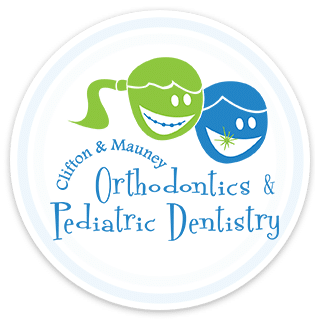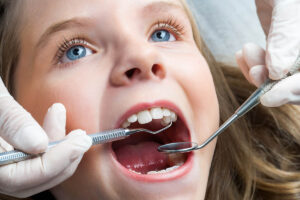Deciding between Invisalign and traditional braces for your teen or child involves considerations of comfort, lifestyle, and the type of tooth movement required. An experienced orthodontist can help you compare options and plan care that fits your family.
Choose Clifton & Mauney for orthodontics in Chapel Hill. Explore Invisalign in Chapel Hill, and then contact our friendly team at 888.506.4035 to schedule a consultation or request an appointment.
What is Invisalign?
Invisalign is an orthodontic treatment that uses a series of clear aligners to straighten teeth. These aligners are custom made from smooth plastic, and each set applies gentle pressure for moving teeth toward a planned alignment. Patients typically wear a set for 1 to 2 weeks before switching to the next aligner in the series, which continues the carefully staged tooth movement.
Because Invisalign aligners are removable, teens can take them out for eating, brushing, and flossing. That flexibility helps protect oral hygiene and can reduce plaque buildup compared with fixed brackets and wires. Evidence suggests that clear aligners perform well for many mild to moderate orthodontic problems and may support easier hygiene during treatment. For an overview of braces and aligners, see ADA MouthHealthy. For research comparing systems, see this systematic review on clear aligners vs fixed appliances.
How traditional braces work
Traditional braces use small brackets attached to each tooth, connected by metal wires that the orthodontist adjusts at regular visits. Traditional metal braces remain the most familiar option, and they are highly effective for complex movements. Options include ceramic braces that blend with tooth color. Some cases use rubber bands to fine tune bite relationships. Because braces are fixed, there is no risk of losing them, which some families appreciate for teens.
Invisalign vs braces: key differences for teens and families
Appearance
- Invisalign aligners are nearly invisible, which many teens prefer for aesthetics and confidence in photos or at school events.
- Traditional braces, including traditional metal braces, are more noticeable. Ceramic braces can be less noticeable but are still visible up close.
Comfort
- Smooth plastic trays tend to reduce irritation on cheeks and gums. Some discomfort is normal after switching to the next aligner.
- Braces use metal brackets and metal wires that can rub the mouth and may require wax while the patient adjusts.
Responsibility and wear time
- Invisalign treatment works best when the patient commits to wearing aligners 20 to 22 hours per day. Aligners must be placed back in the mouth after eating and brushing.
- Braces are fixed, so compliance is built in. For some teens, that security makes daily routines simpler.
Eating and diet
- With Invisalign, teens remove clear aligners to eat, so there are virtually no food restrictions. They should brush before putting aligners back to prevent plaque and bad breath.
- With regular braces, certain hard or sticky foods can break brackets or wires. Families often adjust diet choices during treatment.
Oral hygiene
- Aligners come out for brushing and flossing, so oral hygiene is straightforward. This may lower the risk of plaque and gingivitis during treatment time.
- Braces demand careful brushing around each bracket and under wires, plus daily flossing with a threader or water flosser to prevent cavities and bad breath.
Treatment time and results
- Both systems can straighten teeth and improve the bite. Treatment time depends on the diagnosis and patient cooperation. Some studies show similar outcomes for suitable cases, while fixed appliances may be preferred for certain complex tooth movements. Your orthodontist will explain what to expect for your child’s plan.
- Severe rotations, major bite corrections, or complex tooth movements sometimes respond better to braces. Decisions are made on a case by case basis.
Cost and coverage
- Many dental insurance plans include orthodontic coverage that can apply to Invisalign treatment or braces.
- Check with your insurance company to understand coverage, waiting periods, and lifetime orthodontic maximums.
Learn more about insurance and payment plan options at Clifton and Mauney.
Who is a good candidate for each treatment option?
- Clear aligners often work well for crowding or spacing that is mild to moderate, relapse after earlier braces, and certain bite refinements.
- Traditional braces are versatile for complex rotations, vertical changes, or when multiple tooth movements must occur at once. In some cases, a hybrid plan starts with braces and then transitions to aligners, or vice versa.
Clinical research indicates that clear aligners can achieve quality results in selected cases, and that periodontal indexes may be favorable with aligners, likely due to easier cleaning. Fixed appliances remain excellent for more complex biomechanics. Your Clifton & Mauney orthodontist will recommend the best option for your child’s orthodontic problems after a thorough exam and imaging.
What to expect during Invisalign treatment
- Consultation and records, including photos, 3D scans, and X‑rays, so the orthodontist can map tooth movement and alignment goals.
- Delivery of the first sets of Invisalign aligners. Attachments, which are small tooth‑colored bumps, may be placed to help with specific movements.
- Daily wear for 20 to 22 hours. Aligners are worn while sleeping, at school, and during most activities.
- Switching to the next aligner as directed, usually every 1 or 2 weeks. The orthodontist will advise how many aligners the plan includes and when to change to the next aligner.
- Checkups every 6 to 10 weeks to monitor progress, adjust the plan, or add rubber bands if needed.
- Refinements as needed to fine tune the smile.
- Retainers after active treatment to help hold teeth in their new positions. Retainers are part of most orthodontic treatments, including braces.
How much does Invisalign cost and how is it paid for?
Many patients use a combination of dental insurance, health savings accounts, and payment plans. Coverage varies; some plans cover a portion of Invisalign treatment similar to braces. Your insurance company can confirm eligibility and any age limits for teens. Clifton & Mauney will review cost details, coverage, and flexible options during your consultation in Chapel Hill so you can decide with confidence.
Why families choose Clifton & Mauney in Chapel Hill
Clifton & Mauney Orthodontics & Pediatric Dentistry serves families across Chapel Hill and the surrounding Triangle community. Our orthodontists evaluate alignment, bite function, and growth, then recommend the best treatment option for your child. Explore clear aligners and compare options in a one‑on‑one visit. We welcome questions about cost, coverage, retainers, and what to expect.
For guidance that is personalized and practical, call 888.506.4035 or request a consultation. You can also learn about teen‑specific features on our Invisalign for teens page.
FAQs: braces or Invisalign for teens
Which is better, braces or Invisalign?
Neither is universally better. For the right case, both can straighten teeth and improve the bite. Traditional braces may be recommended for complex movements. Invisalign treatment can be ideal for motivated teens who will wear aligners as directed.
What are the negatives of Invisalign?
Success depends on wearing the aligner trays most of the day. Losing trays or not wearing them enough can delay progress. Some movements may be less efficient with aligners, and refinements are sometimes needed.
Why do some dentists not recommend Invisalign?
Orthodontists tailor care to the diagnosis. If your child needs specific biomechanics, braces could be the best option to reach the safest, most predictable result. Recommendations reflect training and what will meet the goals.
Can a 13 year old get Invisalign?
Yes, many teens around this age are candidates. Suitability is determined case by case after an exam. Learn more about teen options on our Invisalign for teens page.
How long does Invisalign take to straighten teeth?
Treatment time varies. Mild cases can finish faster, and complex cases take longer. Wearing aligners as prescribed and keeping excellent oral hygiene support the best results.
How many aligners will my child need?
The number depends on treatment goals and the starting alignment. Your orthodontist will estimate how many aligners at the planning stage and will adjust if refinements are needed.
Will dental insurance cover Invisalign?
Many plans include orthodontic coverage that can apply to clear aligners or braces. Benefit rules differ, so check with your insurer about coverage amounts, waiting periods, and age limits.
Is Invisalign worth it for teens?
For teens who value appearance and can commit to wearing trays daily, Invisalign aligners can be a great fit. For teens who prefer a fixed system with no daily decisions, braces may be best.




